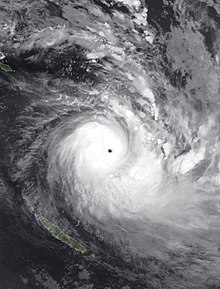 Cyclone Harold at peak intensity shortly after crossing Pentecost Island in Vanuatu on April 6 | |
| Meteorological history | |
|---|---|
| Formed | April 1, 2020 |
| Extratropical | April 10, 2020 |
| Dissipated | April 11, 2020 |
| Category 5 severe tropical cyclone | |
| 10-minute sustained (FMS) | |
| Highest winds | 230 km/h (145 mph) |
| Highest gusts | 325 km/h (200 mph) |
| Lowest pressure | 920 hPa (mbar); 27.17 inHg |
| Category 5-equivalent tropical cyclone | |
| 1-minute sustained (SSHWS/JTWC) | |
| Highest winds | 270 km/h (165 mph) |
| Lowest pressure | 909 hPa (mbar); 26.84 inHg |
| Overall effects | |
| Fatalities | 31 |
| Missing | 22 |
| Damage | $124 million (2020 USD) |
| Areas affected | Solomon Islands, Vanuatu, Fiji, Tonga |
| IBTrACS / [1][2] | |
Part of the 2019–20 South Pacific cyclone season | |
Severe Tropical Cyclone Harold was a very powerful tropical cyclone which caused widespread destruction in the Solomon Islands, Vanuatu, Fiji, and Tonga during April 2020. It was the first Category 5 tropical cyclone in 2020. The seventh named storm of the 2019–20 Australian region cyclone season, eighth named storm, and fourth severe tropical cyclone of the 2019–20 South Pacific cyclone season, Harold was first noted as a developing tropical low within a trough of low pressure during April 1, while it was located to the east of Papua New Guinea. Over the next day, the system moved south-eastwards over the Solomon Sea, before it was classified as a tropical cyclone and named Harold by the Australian Bureau of Meteorology. The system moved into the Fiji Meteorological Service's area of responsibility on April 2 and began to explosively intensify by April 3, reaching Category 4 status by April 4 on both scales. The next day, it further strengthened into a Category 5 severe tropical cyclone, the highest rating on the Australian scale. It made landfall on Espiritu Santo on April 6 and the next day, strengthening to its peak intensity, attaining Category 5-equivalent intensity on the Saffir–Simpson scale before making landfall on Pentecost Island. Moving east, it weakened below Category 5 intensity on both scales over subsequent days. It regained Category 5 severe tropical cyclone status (on the Australian scale only) while passing south of Fiji, before weakening and becoming extratropical on April 9.
Harold was the first Category 5 severe tropical cyclone to occur in the South Pacific basin since Cyclone Gita in 2018 and was also the second-strongest tropical cyclone to ever affect Vanuatu, behind Cyclone Pam in 2015.[3] In total, 27 people died on the MV Taimareho (in the Solomon Islands), two died in Vanuatu, and one died in Fiji.
- ^ "Tropical Cyclone Harold Scraping Parts of Tonga After Hammering Fiji and Vanuatu". The Weather Channel. Archived from the original on February 28, 2021. Retrieved March 10, 2021.
- ^ "Reports of Injuries, Damaged Buildings from Cyclone Harold in Fiji". The Weather Channel. Retrieved March 10, 2021.
- ^ "Vanuatu Reeling from Category 5 Harold, Now Steaming Toward Fiji". Weather Underground. April 6, 2020. Retrieved April 6, 2020.